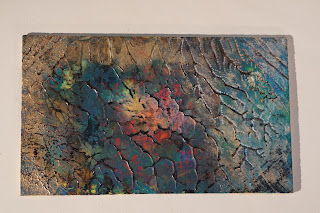This piece is reminiscent of the portraiture of Mao that exists today throughout China. The nationalistic portraiture style is predominant in art from the revolutionary era.
Mao is positioned in a way and his face is portrayed in such a way that is deliberately reminiscent of the iconic photo Alberto Korda portrait of Che Guevara "Guerrillero Heroico", with which we are all familiar.
The irony here is meant to showcase a conflicting consensus emotion that prevails in the West - revolutionaries that don't succeed become romantic folklore. Revolutionaries who do succeed become cultural monoliths, and some might even say, despots and demagogues.
I would like to reference the following article by Kyle Fonay, On Guerrilla Warfare: Two Takes, Mao vs. Guevara on this matter, an excellent synopsis of the comparison and contrast of the two men. But the point of THIS article and this work is not that there are strong parallels between Guevara's Marxist thinking and between Mao's platform of Leninism-Marxism, but that Mao was considered a romantic and noble figure at the beginning of the Chinese revolution, and in fact, by many, for years afterwards. Over time, views of Mao in China changed, as can be seen through the many works of Chinese fiction on the topic; I can recommend a particularly excellent work by Yan Lienke, Lenin's Kisses, which explores deeply and unflinchingly the impact of the Cultural Revolution on, especially, rural China. I can also recommend Mo Yan's Pulitzer Prize winning novel, The Garlic Ballads, as well as Red Sorghum, both of which powerfully encapsulate the struggle of the revolution and the toll it took upon the people. Mo Yan's works were originally banned in China, where such works of dissenting literary courage are officially frowned upon. The volume of his Chinese readership, however, belies the party line. Artists such as Ai Wei Wei continue this brave dissent, which further champions the cause of the people, as well as their freedom to dissent.
Part of the danger of the Cultural Revolution was the approach taken to class struggle. As well as economic disparity, the Red Guard sought to eradicate intellectualism as another source of class enmity. The idea that intellectual equality could be conflated with class equality is reminiscent of Orwell's forboding "Ignorance is Strength."
Another important element in creating revolution is struggle and a cause against which to rally. If there is no struggle, there is no motivation for endurance of privation, nationalism, and other such emotions necessary to support such forward momentum. It is reminiscent of Orwell's Oceania and Eurasia; an interchangeable enemy that can promote the idea that "War is Peace", in that a country united against a common foe is less likely to turn upon itself. Which is ironic in a post-revolutionary setting to say the least. Once the revolution won, against whom shall we revolt?
One maxim remains; "Freedom is Slavery". The idea that the burden of decision creates suffering; that we are happier not being tasked with the power to determine the events that concern us; that we are better trusting in the government, our 'Big Brother', who is watching out for us, rather than to vex ourselves with its machinations..... I'll never forget a friend who empathized with Americans HAVING to vote, and that it must be stressful. But that's interesting, isn't it? Considering how infrequently and sporadically we DO vote. City and state elections have abysmally low voter turnout rate, and our last presidential exercise garnered a scant-of-60%. Most people would give the excuse that their vote doesn't matter, or that it was stressful or inconvenient to do so. The idea that civil liberties are our hotbutton issue on many contentious points of domestic policy, and that the constriction of society is viewed as a boon should also be alarming. Homogenity, comfort and subsistence complacency seem to be enough of an opiate for the masses they are intended to protect and preserve, but on the other side of that preservation lie the casualties of such policy, and the collateral detritus of a system that views class warfare as a social control tool.
And the Warhol influence? One could posit it forward as a commentary on the consumer culture and commodification culture that has spread like wildfire through the post revolutionary economic boom that came with globalization. Or one could say that I simply just really like Warhol. You pick.
The joss paper is an interesting visual effect, as well as a subtext; joss paper (or "ghost" paper) is burned as an offering for ancestors in the afterlife. It is viewed as a prayer to communicate with past generations.
This is a reference to those who died fighting for and against these ideals, in a hope that we may learn something from it.

Portrait of Chairman Mao is framed in reclaimed boxcar wood, and is for sale. Please contact us at Dada.Collective.Gallery@gmail.com.



























































